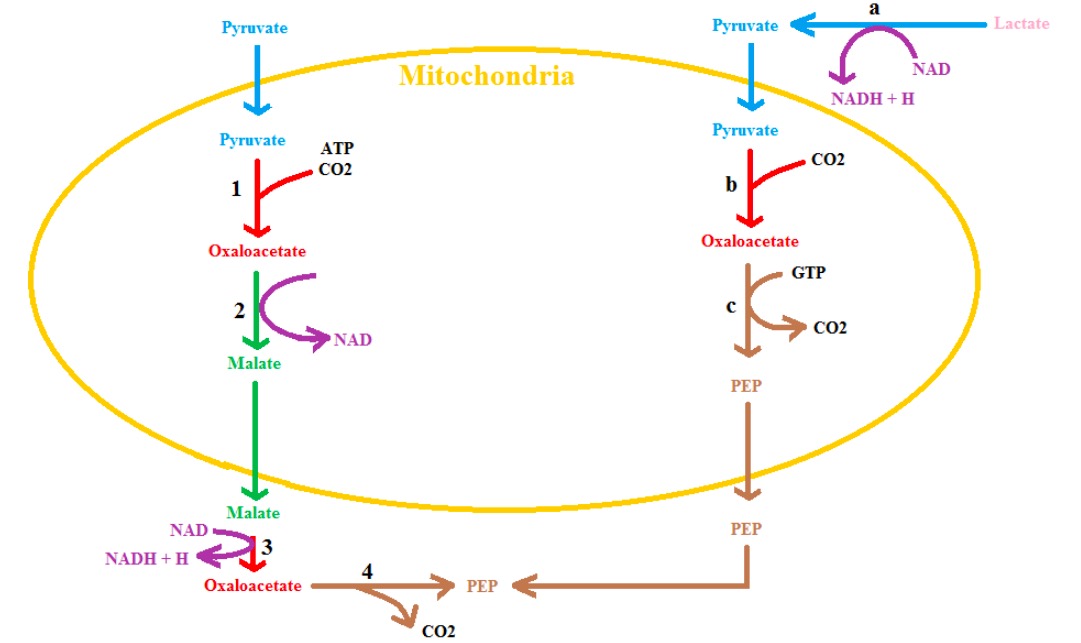Playlist
Show Playlist
Hide Playlist
Gluconeogenesis: Metabolism of Galactose
-
05 Advanced CarbohydrateMetabolism2.pdf
-
Reference List Biochemistry.pdf
-
Download Lecture Overview
00:01 In a previous lecture I described the way in which glucose is broken down. 00:05 But glucose is not the only sugar that we ourselves need to deal with. 00:08 In this lecture I will talk about the metabolism of other sugars. 00:12 I will discuss the process of gluconeogenesis, that's the way cells make glucose that they can use. 00:17 And then last I will talk about the phenomenon of reciprocal regulation, the way cells control sugar metabolism. 00:26 Now cells have a lot of different sugars that they get besides glucose. So it's important that we understand something about what they do. 00:33 In this pathway we see that metabolism of a sugar known as galactose. 00:38 Now we get galactose in our diet fairly regularly if we eat dairy products because galactose comes from lactose which is known as milk sugar. 00:47 So our cells have to be able to metabolize galactose. 00:51 To metabolize galactose, the metabolism is actually shown on the screen. 00:54 I am gonna step you through it and it looks a little complicated but it is actually fairly simple. 01:00 The reactions of galactose basically involve its conversion into an intermediate in glycolysis. 01:06 Now this starts with an enzyme that has a mouthful of a name: galactose-1-phosphate uridyl transferase. 01:13 Hopefully, the reaction is simpler then the name of the enzyme is. 01:16 The reaction catalyzed by this enzyme takes galactose-1-phosphate on the upper left and combines it with UDP glucose on the lower left. 01:26 And what it’s doing is essentially swapping the galactose for the glucose. 01:31 So we see when this process happens that we start with galactose-1-phosphate and we end up with UDP galactose. 01:39 UDP glucose releases a glucose-1-phosphate. 01:42 So because of that we now have glucose-1-phosphate that is free. 01:47 A glucose-1-phosphate is relatively easy to get into glycolysis because there is an easy enzymatic conversion of glucose-1-phosphate to glucose-6-phosphate and we get into glycolysis. 01:57 This means we have converted part of the molecule shown on the screen into glycolytic intermediates. 02:02 The galactose in the UDP, however, has to also be converted into intermediate. 02:08 And that happens in the next reaction which is catalyzed by UDP-galactose-4-epimerase. 02:14 Again a mouthful of a name, but the reaction is quite simple. 02:17 The galactose at the end of the UDP is converted into a glucose. 02:22 That reaction means that we have now got into a point where we have made our starting material. 02:28 UDP-glucose on the right. UDP-glucose on the left. 02:30 The UDP-glucose on the left now continues the process metabolizing more lactose. 02:35 So in this way all galactose can ultimately be converted into glycolytic intermediates. 02:43 Now other sugars get metabolized, I have mentioned lactose. Lactose is milk sugar and it's metabolized in a very simple way. 02:51 There is an enzyme called lactase and lactase breaks lactose into its constituent sugar which are galactose and glucose. 02:59 You have seen how galactose is metabolized. 03:02 Now lactase is an important enzyme; because, in some adults the reduced quantities of this enzyme leads to a phenomenon known as lactose intolerance. 03:12 And lactose intolerance, if you ever had to deal with, that is pretty discomforting; because, it causes the bacteria in the stomach to be able to produce a lot of gas because they are working on lactose not galactose and glucose.
About the Lecture
The lecture Gluconeogenesis: Metabolism of Galactose by Kevin Ahern, PhD is from the course Carbohydrate Metabolism.
Included Quiz Questions
Which of the following is true regarding the breakdown of galactose?
- It is converted into an intermediate of glycolysis.
- It is combined with UDP-lactose.
- It requires lactase.
- It produces fructose.
- It first must be recombined with glucose to form lactose.
Which of the following enzymes is NOT matched correctly to the reaction it catalyzes?
- Galactose-1-phosphate uridyl transferase: glucose-6-phosphate + GDP-glucose
- Lactase: lactose → glucose and galactose
- Galactose-1-phosphate uridyl transferase: galactose-1-phosphate + UDP-glucose → UDP-galactose + glucose-1-phosphate
- UDP-galactose-4-epimerase: UDP-galactose → UDP-glucose
Customer reviews
5,0 of 5 stars
| 5 Stars |
|
2 |
| 4 Stars |
|
0 |
| 3 Stars |
|
0 |
| 2 Stars |
|
0 |
| 1 Star |
|
0 |
Really a great and elaborate presentation. Thanks Prof. Kevin. Now I no longer struggle in cramming Biochemistry but rather find the subject interesting. I wish I started using your lecture guide early in Medical school, but any way not yet late! Thank you once again.
It's unfathomable how much this lecture has saved my time. Though I would appreciate a quick-summary of the products turning into intermediates for other cycles. Like with how g-1-p turns into g-6-p




